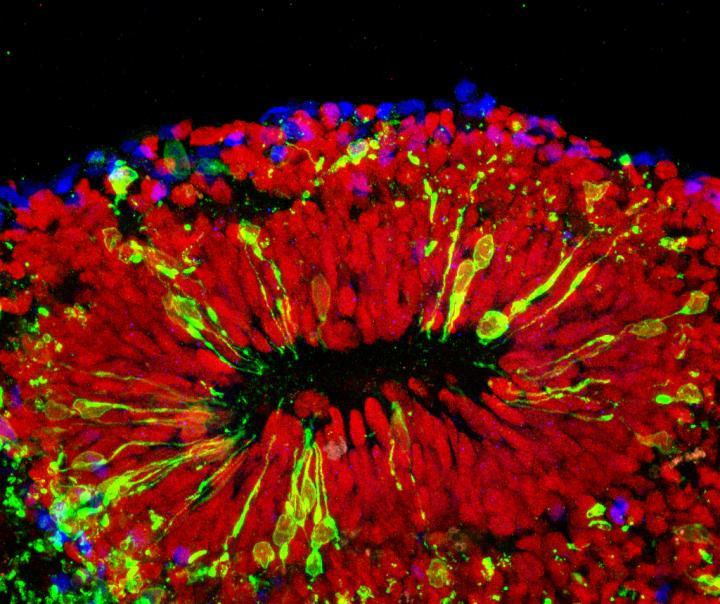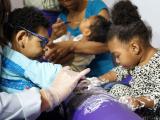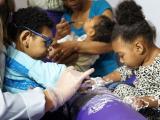Another lab team working on "minibrains" to unravel questions about how Zika virus might damage developing fetal brains reported new findings today, suggesting a more severe impact in the early stage of pregnancy.
In outbreak developments, Mexican scientists have detected Zika virus in Aedes albopictus mosquitoes collected from the environment—a first for the Americas—and the World Health Organization (WHO) shared details on the first local Zika cases in Papua New Guinea.
Also, the US Centers for Disease Control and Prevention (CDC) and the Occupational Safety and Health Administration (OSHA) today issued guidance for protecting workers from occupational Zika virus exposure.
'Minibrain' tests show severe effects
Aside from the new findings in the minibrain (organoid) study, the experiments have an unusual twist: the involvement of high school interns in the Johns Hopkins lab. The students suggested that parts for a new bioreactor that efficiently makes the minibrains could be produced using a 3-D printer. The findings appear today in the latest issue of Cell.
Hongjun Song, PhD, a neurology professor at Johns Hopkins and study coauthor, said in a press release from the university that the more realistic 3-D model confirms what researchers suspected from their work with two-dimensional cell culture. Those experiments showed the virus's capacity to cause microcephaly by infecting neural progenitor cells.
The group was able to use the improved bioreactor to make different types of minibrains that allow them to test infection in different brain areas—the front, middle, and back. Using the forebrain model, they tested the effects of the virus at different stages of pregnancy.
They found that infection in early pregnancy affected neural progenitor cells, with severe effects including stunted growth and disintegration. At a stage that mimics second trimester brain development, Zika virus still infected neural progenitor cells, but also affected neurons, resulting in slowed growth and cortex thinning.
The researchers said the patterns they saw in minibrain lab modeling seem to be consistent with the clinical picture of babies born with microcephaly. They said their next step is to test already-approved drugs to see if they offer any protection against Zika virus.
Outbreak region highlights
In other news, tests as part of mosquito surveillance in Mexico's San Luis Potosi state have confirmed Zika virus in A albopictus mosquitoes for the first time in the Americas, the Pan American Health Organization (PAHO) said yesterday in its regular Zika update.
Real-time polymerase chain reaction testing confirmed the virus in the mosquitoes on Apr 1, PAHO said. Mexico has already reported local spread of the disease in a handful of its states. San Luis Potosi is in central Mexico.
A aegypti mosquitoes are the main carrier of the disease, but health officials have said A albopictus is also a potential vector.
Cases in Papua New Guinea
In Pacific region developments, the World Health Organization (WHO) today noted six local cases in Papua New Guinea. The cases were identified retrospectively during testing for febrile diseases between July 2014 and March 2016.
One positive sample was found in connection with a 2015 malaria outbreak, two were found during a dengue outbreak in December 2015, and three were found during a dengue outbreak in February 2016. None of the patients had traveled outside the country.
Elsewhere in the region, a Zika-linked microcephaly case has been reported in the Marshall Islands, the European Centre for Disease Prevention and Control (ECDC) said today in its weekly communicable disease update. It said in March the mother tested positive for earlier Zika virus infection.
CDC, OSHA issue worker protection guidance
New federal guidance today offers Zika-protection strategies for workers in outdoor, mosquito, lab, healthcare, and business travel settings, according to a press release from the CDC. The new guidance walks employers through steps on how to protect their workers and how workers can protect themselves from mosquito bites and contaminated blood.
For example, in outdoor work settings, the guidance recommends that employers consider reassigning to indoor tasks women who are pregnant or who are considering getting pregnant as well as male sexual partners of women who fit those two categories. The guidance also suggests that employers educate workers on Zika prevention tactics, such as covering exposed skin and wearing insect repellent.
So far there haven't been any known cases related to healthcare exposure, but the CDC said exposure to body fluids should be minimized to reduce the possible threat. In earlier guidance, the CDC recommended standard precautions to protect medical staff from Zika and other bloodborne pathogens.
Other developments
- News coverage in the wake of public health announcements about Zika virus offers a brief window of opportunity for engaging the public about the threat and how they can take precautions, researchers from North Carolina's RTI International reported yesterday in a letter to Emerging Infectious Diseases. They based their findings on an analysis of Google searches after major outbreak developments, such as on Jan 28 after the WHO announced that Zika was spreading "explosively" and the CDC announced a travel alert.
- The University of Pittsburgh Graduate School of Public Health on May 5 will formally announce a joint project called "Cura Zika" with Brazil's Fiocruz Institute to speed up funding for Zika virus research, according to a statement from the school. The effort has $1 million in startup funds from the school and anonymous donors.
- Protein Sciences and two South American groups recently announced an agreement to jointly develop a recombinant Zika virus vaccine based on the virus's envelope (E) protein, according to an Apr 19 statement from the company.
See also:
Apr 22 Cell abstract
Apr 22 Johns Hopkins press release
Apr 21 PAHO report
Apr 22 WHO statement on Papua New Guinea cases
Apr 22 ECDC weekly communicable disease report
Apr 22 CDC press release





















